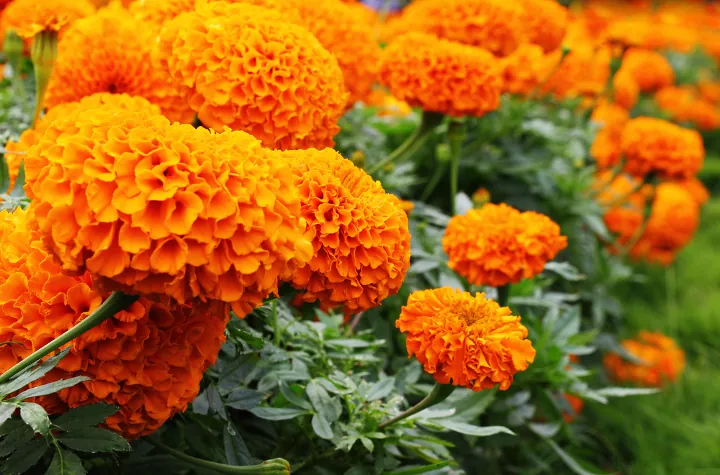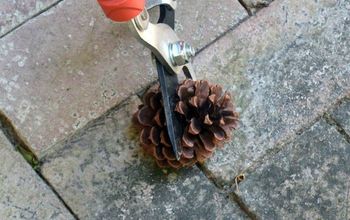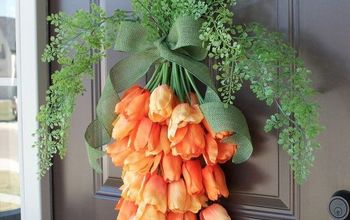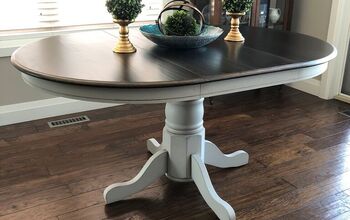How to Grow Beautiful Marigolds for a Splash of Color

Beautifully bright marigolds are low-maintenance annuals that deserve a place in every garden. They sprout quickly, reliably bloom within two months, last all summer and into fall, and have very little disease and insect issues.
For these reasons, marigolds make for a colorful and satisfying addition to the yard that both gardening newbies and aficionados can appreciate.
Plus, even though they’re technically annual flowers, it’s almost guaranteed that they’ll come back and bloom year after year without you having to lift a finger.
Dig into this breezy how-to guide to growing the cheerful flowers yourself.
Photo via Plastic What You Preach
About Marigolds
Marigolds (Tagetes species) are easy-to-grow plants that have pom-pom, daisy-like, or anemone-shaped flower heads. Their bloom colors range from yellow and gold to orange, red, and mahogany.
Knowing a little bit about marigold history makes growing them even more exciting: Marigolds date back to the Aztec people, who valued them for their magical, religious, and medicinal properties.
By the 1920s, marigolds had become a popular garden choice, and breeding had produced hundreds of new varieties—with even more variations hitting the market each year in the present day.
There are an estimated 50 species of marigolds, with most identifying as annuals, though a few are perennials. It’s easy to confuse the types, since marigolds self-seed, meaning the plants produce seeds that fall back into the ground every year to replant themselves. So while they appear to be perennials, they’re actually just growing back from their own seeds.
Photo via Carasia Landscaping
Types of Marigolds
There are two main species of marigolds you’ll come across at the garden nursery: French marigolds (Tagetes patula) and African marigolds (Tagetes erecta). French marigolds have a compact structure and small flowers in comparison to African marigolds, which have blooms up to four inches across. You’ll also see African marigolds sometimes referred to as American marigolds and Mexican marigolds.
When to Plant Marigolds
Plant African marigold varieties in early spring, once the chance of frost in your hardiness zone has dissipated. Since African marigolds are taller, planting them earlier in the season gives them time to grow, since they are slower to mature and produce flowers. You can plant French marigolds any time from spring through midsummer.
For most marigolds, you can sow seeds directly into the garden come spring, once the soil is warm enough—about 70-75 degrees Fahrenheit (investing in a soil thermometer will help you figure out its temperature). You can also start seeds indoors about two months prior to the last anticipated frost date. Once the seeds germinate and start to sprout, transplant them outdoors after the last frost.
Where to Plant Marigolds
The majority of marigold varieties thrive in areas with full sun, but they can tolerate some shade—which is especially appreciated if you live in a hot climate.
Due to their tall, lanky structure, African marigolds will benefit from being planted in an area protected from harsh elements, like strong winds and heavy rainfall. Marigolds can grow in just about any soil, but they’ll flourish in moderately fertile, well-drained soil.
If you’re planting a veggie garden, you’re in luck: According to the Old Farmer’s Almanac, French marigolds are particularly known for repelling harmful nematodes (microscopic worms) that attack the roots of garden vegetables.
If you’re planning a vegetable garden with a fall harvest, consider planting marigolds where you intend to grow fall crops. When late summer approaches, remove the marigolds and plant your vegetables and greens.
How to Plant Marigolds
Depending on the type of marigold you choose to plant in your garden, there are two ways to plant: from seed or by transplants. French marigolds can easily be started from seed since they germinate so quickly. On the other hand, African marigolds are best purchased as young plants, since they can take a long time to flower.
Planting Marigolds from Seed
If you plan to grow marigolds from seed, start seed shopping in the winter. As we mentioned earlier, it’s best to start marigolds from seed about two months before your region’s anticipated frost date, but check the directions on the back of the seed packet just to be sure.
Tools and Materials Needed
- Hose or watering can
- Garden rake
- Garden gloves (optional)
- Marigold seeds
1. Wet Soil
Wet the soil lightly several hours before sowing. The soil should be moist to the touch but not soggy when planting.
2. Rake and Level Soil
Rake back some of the soil to use for covering the seeds. Level out the soil and pat down until firm.
3. Plant Seeds
Sprinkle some seeds into the palm of your hand, then place groups of three to four seeds on the soil, spacing them 6-12 inches apart (depending on whether you chose a smaller or larger variety of marigold—check the back of your seed packet for a recommendation). Gently press the seeds into the soil, then cover lightly with the saved soil. The seeds should be buried ½-inch deep.
4. Water
Pat and smooth the soil gently, then water with a gentle setting on your hose (or watering can). Water daily until seedlings sprout. Once sprouted, begin to taper off watering and give plants one inch of water per week.
Planting Marigolds from Transplants
Marigold transplants will likely hit garden nurseries at the beginning of the summer. When it comes to planting these young plants directly in the ground, aim to do that once the soil has reached 70 degrees F.
Tools and Materials Needed
- Hose or watering can
- Garden rake
- Garden gloves (optional)
- Compost
- Garden knife
- Young marigold plants
1. Prepare Bed
If beginning with marigolds purchased at a nursery, prepare a bed for the plants two weeks prior to transplanting them. Choose a sunny site and one where water drains well. Break up the soil to a depth of 6-8 inches. Add a 3-inch layer of compost to the bed.
2. Water the Transplants
Water the plants well and let them dry to a damp state before planting.
3. Dig the Holes
Dig a planting hole for each marigold, making sure each hole is slightly larger than the rootball that will be placed within it. Space each hole 8-10 inches apart for French marigolds and 10-12 for African.
4. Transplant the Marigolds
Remove the marigolds from their containers. Inspect each rootball, slicing the outermost layer of any that appear pot-bound (when the roots are matted in thick layers around the rootball). Lightly tug on the roots until they freely hang. Place the marigolds in the planting holes, splaying the roots out.
5. Backfill and Water
Backfill with soil and press firmly into place, then water the base of each marigold thoroughly.
Photo via Plastic What You Preach
How to Care for Marigolds
You’ve put the work into growing your marigolds, now it’s time to properly care for them so that they’ll have a long bloom season and self-seed to come back next year. Here are a few marigold care tips to keep these bloomers strong all season.
Watering
Water marigold plants well at the base, then ensure the soil is moderately dry before watering again. In extreme heat, you’ll find that the soil will dry quicker and that you’ll have to water more often.
Pinching and Deadheading
There’s no need to deadhead marigolds, but once the blooms have wilted, pinch off the tops of the plants. This will encourage more blooming and bushier growth later in the season and will keep the plant healthy.
Fertilizing and Mulching
Avoid fertilizing marigolds during growth, as the nitrogen in the soil will boost foliage but can hinder flower production. You can add mulch around the marigolds once planted to prevent weeds from growing around them—as a bonus, mulch will also help keep the soil moist for longer, which will be helpful in hotter months.
Pest and Disease Control
Compared to other plants, marigolds have few pests and diseases, so you should sleep well knowing there won’t be many unwanted visitors near them. Marigolds may occasionally suffer a spider mite or aphid infestation, but this can easily be cured by simply spritzing the plants with water or an insecticide soap every other day until the pests are gone (it usually takes a week or two).
Fungal diseases like powdery mildew can take form on marigold leaves if they’re exposed to too much water. For this reason, it’s best to water at the base of the plant and to space marigolds out at their recommended lengths so they’re not on top of each other.
Planting marigolds is a simple and rewarding process. By following the steps outlined above, you can successfully grow vibrant and healthy marigolds in your garden. With a little care and patience, you will soon have a beautiful bed of marigolds adding color and charm to your garden.
Have you grown marigolds in your garden? If so, give us your best tips and tricks below!
Enjoyed the project?
Comments
Join the conversation
-
 Thomas hogan
on Oct 05, 2021
Thomas hogan
on Oct 05, 2021
Have grown marigold once , but it was a disaster lol , will try my best to learn more from here and to be able to grow it well again , thank u
-
-
 Clergylady
on Dec 19, 2023
Clergylady
on Dec 19, 2023
I be have a large raised bed that has grown marigolds for years. The seeds come up thick so I transplant from there to the yard and garden. It has over time become mostly one color so I plan to add seeds for other colors this year and again transplant to the garden from that bed. I may add seed to the new orchard as well. The colors around the new trees will look nice.
-






























Frequently asked questions
Have a question about this project?